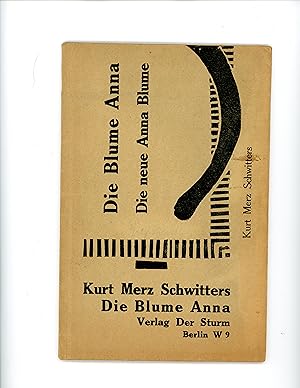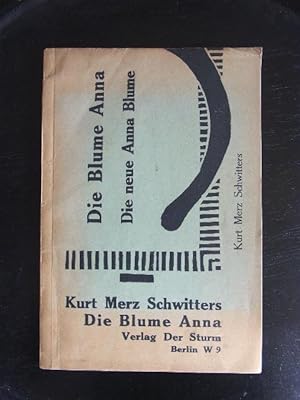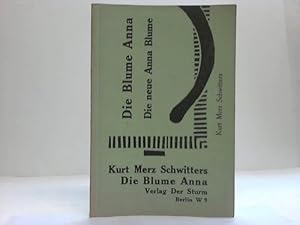Blume Anna Neue by Kurt Schwitters, First Edition (10 results)
FeedbackSearch filters
Product Type
- All Product Types
- Books (10)
- Magazines & Periodicals (No further results match this refinement)
- Comics (No further results match this refinement)
- Sheet Music (No further results match this refinement)
- Art, Prints & Posters (No further results match this refinement)
- Photographs (No further results match this refinement)
- Maps (No further results match this refinement)
- Manuscripts & Paper Collectibles (No further results match this refinement)
Condition Learn more
- New (No further results match this refinement)
- As New, Fine or Near Fine (3)
- Very Good or Good (No further results match this refinement)
- Fair or Poor (No further results match this refinement)
- As Described (7)
Binding
- All Bindings
- Hardcover (No further results match this refinement)
- Softcover (7)
Collectible Attributes
- First Edition (10)
- Signed (No further results match this refinement)
- Dust Jacket (No further results match this refinement)
- Seller-Supplied Images (7)
- Not Print on Demand (10)
Language (1)
Price
- Any Price
- Under US$ 25 (No further results match this refinement)
- US$ 25 to US$ 50 (No further results match this refinement)
- Over US$ 50
Free Shipping
Seller Location
Seller Rating
-
Elementar. Die Blume Anna. Die neue Anna Blume. Eine Gedichtsammlung aus den Jahren 1918-1922. Einbecker Politurausgabe.
Published by Berlin Verlag Der Sturm (), 1923
Seller: Sächsisches Auktionshaus & Antiquariat, Leipzig, Germany
First Edition
US$ 352.95
Convert currencyUS$ 17.13 shipping from Germany to U.S.A.Quantity: 1 available
Add to basket* 32 Seiten. 23 x 15,5 cm. Typographisch gestaltete Original-Broschur (etwas verblichen und randgebräunt, kleine Fehlstelle am oberen Kapital professionell mit Japan ausgebessert) nach einem Entwurf von Kurt Schwitters. *** Wilpert-Gühring 5. Raabe, Autoren 273, 5. - Erste Ausgabe der Anna Blume-Textsammlung des legendären Dada-Gesamtkünstlers. - Papierbedingt stärker gebräunt, sonst schön erhalten.
-
DIE BLUME ANNA. DIE NEUE ANNA BLUME
Published by Berlin, Verlag Der Sturm, 1922
Seller: Librairie Benjamin Pitchal, Brussels, Belgium
First Edition
US$ 352.95
Convert currencyUS$ 9.14 shipping from Belgium to U.S.A.Quantity: 1 available
Add to basketCouverture souple. Condition: Très bon. Edition originale. In-8 (227 x 150 mm) de 32pp. Broché, couverture typographique. Bord de la quatrième de couverture légèrement passé. Edition originale.
-
Die Blume Anna. Die Neue Anna Blume
Published by Berlin, Verlag Der Sturm, 1922
Seller: Largine, Madrid, M, Spain
First Edition
US$ 352.95
Convert currencyUS$ 16.56 shipping from Spain to U.S.A.Quantity: 1 available
Add to basketEncuadernación de tapa blanda. Condition: Muy bien. 1ª Edición. 32 pp.
-
elementar. Die Blume Anna. Die neue Anna Blume. Eine Gedichtsammlung au den Jahren 1918-1922. Einbecker Politurausgabe.
Published by Berlin, Der Sturm, 1923., 1923
Seller: Antiquariat CoBrA, Oberrohrbach, Austria
First Edition
US$ 1,588.28
Convert currencyUS$ 59.40 shipping from Austria to U.S.A.Quantity: 1 available
Add to basketBerlin, Der Sturm, 1923. SEHR GUTES EXEMPLAR 23 x 15,5 cm. 32 Seiten. Typographisch gestalteter OKarton, nach einem Entwurf von Schwitters. Erste Ausgabe. - Sammlung von Gedichten und Prosatexten. - Raabe 431, 273; Motherwell-Karpel 367; Schmalenbach-Bolliger 4; - Selten. Near fine copy. Sprache: Deutsch. *** Bitte kontaktieren Sie uns immer BEVOR Sie bestellen! Für ausführliche Beschreibungen und Bilder sowie günstigere Versandoptionen kontaktieren Sie mich bitte per Email! Please contact us always BEFORE you order! For detailled descriptions and photos as well as cheaper shipping options please send an email! ***.
-
Die Blume Anna. Die neue Anna Blume, eine Gedichtsammlung aus den Jahren 1918-1922.
Published by Berlin: Der Sturm, 1922
Seller: Michael Fagan Fine Art & Rare Books, Newton, MA, U.S.A.
First Edition
Soft cover. Condition: Near Fine. 1st Edition. Large octavo 22.7x15 cm., wrappers, 32pp. Schwitters initially published the poem Anna Blume in 1919 in Der Sturm magazine. It was published later that year under Steegemann's die Silbergaule. The present publication brings together a variety of poetic experiments with page design and was released as a Sturm-Buch, incorporating new material, including Klang-Gedichte (sound poems) and great inventiveness throughout. A nonaligned individual with great originality, Schwitters was never accepted by the Dadaists whose work his paralleled because it utilized more conventional outlets. Crisp, near fine condition with small light stain on front cover, ex-coll with bookplate of Hannes Schwenger, noted poet, editor and political activist.
-
Elementar. Die Blume Anna. Die neue Anna Blume. Eine Gedichtsammlung aus den Jahren 1918 - 1922. Einbecker Politurausg.
Published by Berlin, Der Sturm, (1923)., 1923
Seller: Antiquariat Seidel & Richter, Fürstenberg Havel, Germany
First Edition
US$ 705.90
Convert currencyUS$ 21.70 shipping from Germany to U.S.A.Quantity: 1 available
Add to basket32 S. Illustr. OBrosch. (Ränder gebräunt u. leichte Knicksp.). Erste Ausgabe. Raabe 273,5; Schmalenbach/Bolliger 4.
-
Elementar. Die Blume Anna. Die Neue Anna Blume. Eine Gedichtsammlung Aus Den Jahren 1918-1922
Published by Verlag Der Sturm, Berlin, 1923
Seller: Winged Monkey Books, Arlington, VA, U.S.A.
First Edition
First Edition. Softcover, green covers slightly darkened, contents slightly toned, very good. 32 pp. Book.
-
Die Blume Anna. Die neue Anna Blume. Eine Gedichtsammlung aus den Jahren 1918-1922. Einbecker Politurausgabe von Kurt Merz Schwitters.
Published by Berlin: Verlag Der Sturm 1922, 1922
Seller: Antiquariat Ulrich Doege, Köln, NRW, Germany
First Edition
US$ 529.43
Convert currencyUS$ 31.98 shipping from Germany to U.S.A.Quantity: 1 available
Add to basket8°, illustr. drahtgehefteter Orig-Kartbd.; 32 Seiten mit typografisch gestalteten Textanordnungen. Erste Ausgabe (Raabe, 273,5). - Der ehemals h'grüne Einband stärker ausgeblichen; Heftseiten nachgedunkelt, aber sauber.
-
elementar. Die Blume Anna. Die Neue Anna Blume eine Gedichtsammlung aus den Jahren 1918-1922. - [THE SYMBOL FOR THE DADAIST MOVEMENT]
Seller: Herman H. J. Lynge & Søn ILAB-ABF, Copenhagen, Denmark
First Edition
US$ 1,891.32
Convert currencyFree shipping from Denmark to U.S.A.Quantity: 1 available
Add to basketBerlin, Verlag Der Sturm, (1923). 8vo. In the original printed wrappers. Light sunning to top of front wrapper. Upper part of spine with a small bump. Ex-libris (Alfred Liede) pasted on to verso of front wrapper. A fine and clean copy. 32 pp. Rare first printing of one of the earliest edition of Schwitter's famous Dadaist 'sound-poems' (i.e. Dada Klang-Gedichten) often seen interpreted as a parody of a love poem. It famously became the symbol for the Dadaist movement, of the chaos and madness of the roaring 1920ies, and it was seen as the birth of a new poetic language. The poem made Schwitters famous overnight and it was parodied in newspapers and magazines, and strongly polarized public opinion throughout the 1920ies. Whilst Schwitters was never an official member of Berlin Dada, he was closely linked to many members of the group, in particular Raoul Hausmann and Hans Arp, and the poem is written in a dadaist style, using multiple perspectives, fragments of found text, and absurdist elements to depict the narrator's emotional state in the throes of love, or of Germany's political, military and economic collapse after the First World War."Schwitter's developed his own version of Dada, which he called MERZ. Reportedly derived from truncating the name of the German bank Commerzbank, it uses not just ready-mades but also objects that had been thrown away. Merz differed in one crucial aspect from Dada: It was art, not anti-art. Best known are Schwitter's non-sense poems that make sense - just not in the usual sense, in the same way that Schwitters did not restrict himself to the usual five physical senses. His poem [the present] identifies Anna Blume as "the beloved of my twenty-seven senses. The poem takes the reader through an accordingly distorted reality with statements, such as "Blue is the color of your yellow hair, and an equally playful disregard of linguistic rules, while following a grammar of the heart, such as in the poem's last sentence: "Anna Blume, you trickle beast, I love your!". "Despite his overtures, however, the Dadaists rejected Schwitters, burning his "Blume" pamphlet at the 1920 Berlin Dada Fair. Too iconoclastic for more conventional artistic movements, Schwitters was too painterly and sentimental for Dadaism. Denied entry by the club he desperately wanted to join, he slapped stickers that said "Anna Blume" wherever he went" he interrupted other artists' talks by barking like a dog. And yet he was as energetic in his artistic activities proper as he was in his provocations, alternating between painting, printmaking, collage, stage design, poetry"."Given Schwitter's drive towards multivalence, all of these interpretations (An Anna Blume as satire, An Anna Blume as both a critique and subsumption of modernity, An Anna Blume as an expressionistic exposure of the sense surrounding modern experience, and An Anna Blume as a deliberately fashioned alchemical parable) are all possible". (Gamard, Kurt Schwitters Merzbau: The Cathedral of Erotic Misery, P. 57).
-
Die Blume Anna. Die neue Anna Blume. Eien Gedichtsammlung aus den Jahren 1918-1922. Einbecker Politurausgabe 1922
First Edition
US$ 352.95
Convert currencyUS$ 43.40 shipping from Germany to U.S.A.Quantity: 1 available
Add to basketVerlag Der Sturm, Berlin, 1922/1923. 32 S., original illustrierter hellgrüner kartonierter Einband, (aufgrund der Papierqualität leicht gebräunt / hinterer Einbanddeckel fehlt)---- Erste Ausgabe / Raabe, 273,5 / Die Ausgabe zeigt Schwitters zunehmendes Interesse an typographischer Gestaltung. Das Buch hat eine durchkomponierte Titelseite mit horizontal und vertikal ausgewogenen Zeilen: Die Zeilen werden im Sinne der holländischen de Stijl-Gruppe als Quadrate zusammengesetzt. Innen ist das Buch zurückhaltend ausgestattet, die einzelnen Texte werden in ihrer Individualität typographisch klar herausgestellt. (Adler/Ernst). Auf dem letzten Blatt ein Gesetztes Bildgedicht von Kurt Schwitters. - 52 Gramm.








![Seller image for elementar. Die Blume Anna. Die Neue Anna Blume eine Gedichtsammlung aus den Jahren 1918-1922. - [THE SYMBOL FOR THE DADAIST MOVEMENT] for sale by Herman H. J. Lynge & Søn ILAB-ABF](https://pictures.abebooks.com/inventory/md/md10774481379.jpg)
